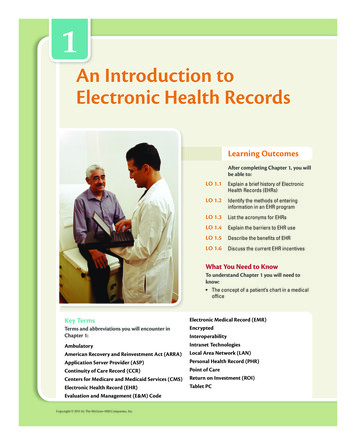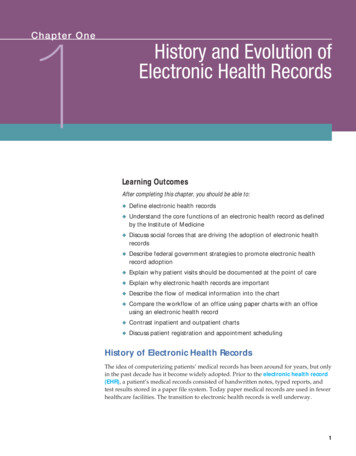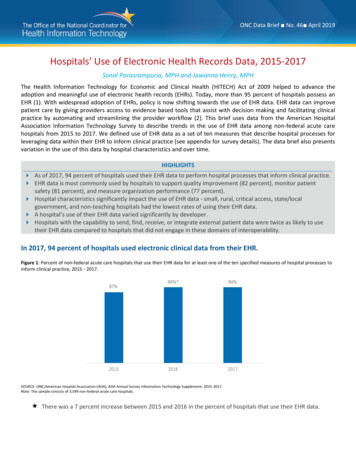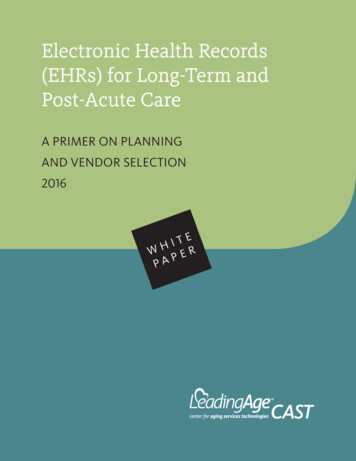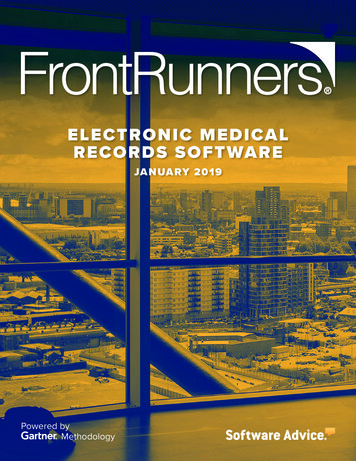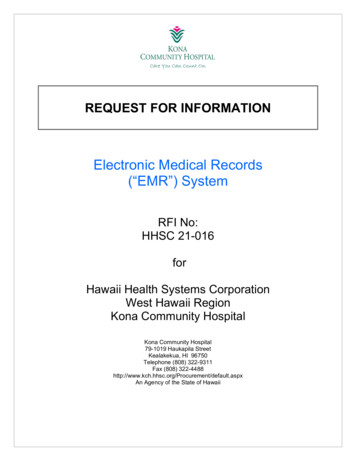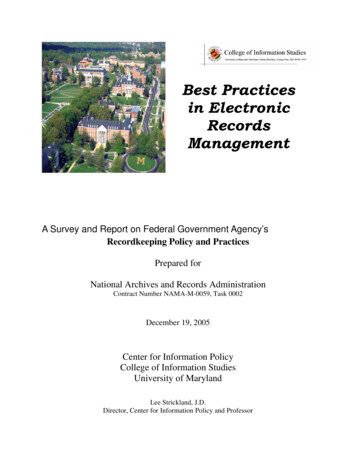
Transcription
Best Practicesin ElectronicRecordsManagementA Survey and Report on Federal Government Agency’sRecordkeeping Policy and PracticesPrepared forNational Archives and Records AdministrationContract Number NAMA-M-0059, Task 0002December 19, 2005Center for Information PolicyCollege of Information StudiesUniversity of MarylandLee Strickland, J.D.Director, Center for Information Policy and Professor
Best Practices in Electronic Records Management--A Survey and Report on Federal Government Agencies’Recordkeeping Policies and PracticesCenter for Information PolicyCollege of Information Studies, University of MarylandSponsored in part byThe National Archives and Records AdministrationContract Number NAMA-M-0059, Task 0002December 19, 2005
AbstractThis report presents the results of the Electronic Records Management Best Practices Surveydeveloped by the Center for Information Policy at University of Maryland with partial fundingfrom the National Archives and Records Administration. The survey collected data primarilyfrom twenty-one federal government agencies, two state government agencies, and one privatesector organization regarding their individual policies and practices for electronic recordsmanagement. The report provides information about the state of electronic records managementin federal agencies; describes barriers to improving the management of electronic records;recommends strategies to improve management at the desktop; suggests approaches tostrengthen NARA’s role; and makes recommendations for future research based on questionsthat arose during the course of the study.Project StaffPrincipal Investigator:Lee S. Strickland, J.D.Co-Principal Investigators:Susan Davis, Ph.D.Stephen Hannestad, M.A., M.I.M.Consultant:Bruce Dearstyne, Ph.D.Graduate Student Researchers:Megan Smith, M.L.S. candidate 2006Juliet Anderson, M.L.S. 2005
Executive SummaryIn order to propose solutions to problems encountered by many government agencies and privatebusinesses when managing electronic records created on desktop computers, the Center forInformation Policy at the University of Maryland completed a study to identify current and bestpractices in electronic records management. The National Archives and Records Administrationprovided partial funding, advice, and reviewed the study in draft. The findings and conclusionsare solely those of the research team, and do not necessarily represent our sponsors. The goal ofthe research was to ascertain the extent to which federal government agencies have adoptedelectronic recordkeeping systems and how the management of electronic records is incorporatedwith traditional records management strategies. After completing research in the field, the ERMresearch team refined the Electronic Records Management Best Practices Survey, based on adraft survey provided by NARA, and administered the questionnaire in three phases:Phase One – On-site interviews with employees from twenty-one federal agencies tocollect survey responses in-person.Phase Two – A web-based survey directed at a larger audience of informationmanagement professionals.Phase Three – Phone interviews with records managers from two state governmentagencies and one private sector business to gather information on recordkeeping policiesand practices for these sectors.Methodology and Data AnalysisThe Electronic Records Management Best Practices Survey consisted of fifty-five closed andopen-ended questions. The data gathered by the ERM Research Team from the on-siteinterviews with federal employees (phase one of the project) was combined with responsesprovided by records managers from two state government agencies and one private sectorbusiness over the phone (phase three of the project). The on-site interviews allowed for anextensive dialogue of actual practices at agencies as well as providing an opportunity to view ademonstration of any electronic records management systems currently in place. Each surveyquestion was analyzed in detail and the full results (often displayed as a chart for clarification)are included in this report.A separate team of researchers from the Masters of Information Management Program at theUniversity of Maryland completed the web-based portion of the survey (phase two of theproject),; thus the results of were analyzed separately from the in-person and phone interviews.The web-based survey (comprised of four sections: records management programs; paperrecords; e-mail records; and electronic records) was available online for 30 days and results werecollected and analyzed from 119 participants. The web-based survey provided information onelectronic records management best practices in organizations beyond the Federal governmentand was used as a basis for comparing and evaluating Federal practices.
Major findings of the Electronic Records Management Best Practices Survey:During the survey administration and analysis of the resulting data from on-site and telephoneinterviews, three major issues stood out to the researchers as problems encountered by themajority of agencies interviewed:1. Agency or office size affects the implementation of Electronic Record KeepingSystems (ERKS); the larger the agency, the more complex the problems associatedwith effective implementation.2. Employees delete electronic records, such as e-mails, one at a time, a cumbersomeprocess which may result in retention of too many records for too long or prematuredisposition that is inconsistent with approved retention schedules.3. Many offices maintain dual, redundant recordkeeping systems – paper and electronic– when all that is necessary is to maintain one record copy.The nature of the survey also allowed the researchers to view and make note of strategies usedby some organizations to help solve these three significant problems. The researchers observedand analyzed several techniques used by federal agencies, reviewed strategies and practicesadvanced in the literature and used by other organizations, and then developed recommendationswhich are intended to be effective and practical. Considering current financial resources, the bestoption for Federal agencies until they are able to implement an official electronic recordkeepingsystem is to synchronize their dual recordkeeping systems and simplify electronic recordsdeletion. This can be done by developing a file plan or classification scheme that describesdifferent types of files maintained in an office, how they are identified, where they are stored,how they should be indexed for retrieval, and references the approved disposition. A sample fileplan and file structure example are included in this report.Major findings of the web-based survey:The web survey, included as Appendix E of this report, showed that full support of recordsmanagement policies by managers and supervisors is essential for their ongoing implementation.Employees need to understand their responsibilities to implement those policies. E-mail is aparticularly important and ubiquitous form of electronic record but procedures for managing itare underdeveloped. Lack of management support and employee understanding of recordsmanagement practices are major explanations for inadequate electronic records management ingeneral and, in particular, for the failure to implement electronic recordkeeping systems.In conclusion, this report advises using a well-crafted, organized, and purposeful file plan as ameans to help alleviate problems transitioning to a full-featured ERKS. A meaningful medianeutral file plan that mirrors both electronic and paper files and follows the same maintenanceschedule will help to consolidate dual systems, assist with regular disposition, and prepare largeragencies for the switch to an appropriate long-term solution.
Table of ContentsA Survey and Report on Federal Government Agency’s . iDecember 19, 2005 . iTable of Contents. iTable of Figures . iiList of Tables . iiiList of Tables . iiiList of Samples . iiiAppendices. iiiIntroduction. 1Background . 2Survey Methodology. 4Data Analysis . 6Study Limitations. 6Questionnaire Results . 6Introductory Section (1-5). 7Office Function and Organization (6-11) . 8Nature of Records (12-15) . 11Agency/Office Records Management Program (16-21) . 13Records Management (22-24). 21Paper and Electronic Records Maintenance (25-32) . 25Maintenance of Electronic Records (33-37) . 32E-mail Records and Web Content Management (37.5-44). 43Future of Records Management and Concluding Remarks (45-55) . 49Data Summary and Trends. 56Introductory Questions (Questions 1 – 5). 56Office Function/Organization and Nature of Records (Questions 6 – 15) . 56Records Management (Questions 16-24). 56Paper and Electronic Records Management and Maintenance (Questions 25-32). 57Electronic Recordkeeping Systems (ERKS) (Questions 33-37). 57E-mail Records (Questions 37.5 – 44). 58Future of Records Management and Concluding Remarks (Questions 45-55) . 59Web Survey. 59Key Problems and Proposed Solutions . 61Problem 1 . 61Proposed Solution . 63Problem 2 . 63Proposed Solution . 65Problem 3 . 65Proposed Solution . 67Future Research Opportunities . 73Conclusion . 75Acknowledgements. 76i
Table of FiguresFigure 1: Agency Categories . 7Figure 2: Level in Agency Hierarchy . 9Figure 3: Records Staff to Total Staff. 11Figure 4: Records Series . 12Figure 5: Records Date Span . 12Figure 6: Most Important Series . 13Figure 7: Storage and Archiving. 16Figure 8: NARA Training. 17Figure 9: Usefulness of Training . 17Figure 10: Accountability & Enforcement . 18Figure 11: Budget .
The Electronic Records Management Best Practices Survey consisted of fifty-five closed and open-ended questions. The data gathered by the ERM Research Team from the on-site interviews with federal employees (phase one of the project) was combined with responses provided by records managers from two state government agencies and one private sector business over the phone (phase three of the .




